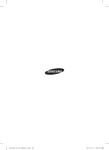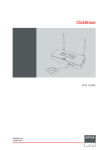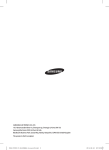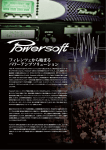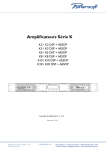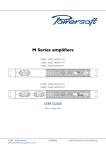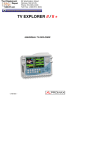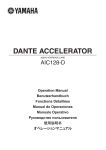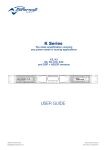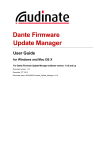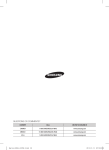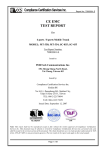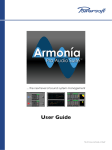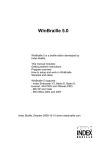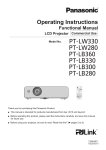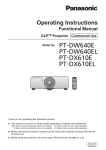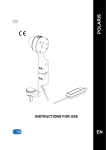Download User Manual - Powersoft Audio
Transcript
X Series High performance professional audio amplifier with auto-balancing multi-phase power supply, built-in loudspeaker management system, signal routing and WiFi remote control capabilities X8, X4 amplifier platforms USER GUIDE September 2014 ©2014 Powersoft DO000148 Keep this manual for future reference People who collaborated on writing this manual: (in alphabetical order) Cati Marco, Chelli Luigi, Franceschi Paolo, Donati Mauro, Gaetti Alberto, Landini Piero, Lastrucci Claudio, Paolinelli Alessandro, Perini Simone. powersoft_XSeries_uguide_en_v1.0 Data are subject to change without notice. For latest update please refer to the online version available on www.powersoft-audio.com X Series User Guide Table of contents 1: Important safety instructions iii 10: Mechanical drawing 2: Importantes instructions de sécurité iv 11: Installation9 3: Instrucciones de seguridad importantes v 11 : 1.Location 9 4: Importanti istruzioni di sicurezza vi 11 : 2.Cooling 9 5: Regulatory information vii 11 : 3.Cleaning 9 6 11 : 4.AC mains supply 6: X Series 1 6 : 1.Welcome 1 11 : 4.1. Three-phase electric power 10 6 : 2.Unpacking & checking for shipping damage 1 11 : 4.2. Bi-phase electric power 11 6 : 3.Disposal of the packing material 1 11 : 4.3. Single-phase electric power 11 6 : 4.About the amplifier platform 1 11 : 4.4. AC MAINS plug and shell 11 10 6 : 4.1. Electric power management 1 12: Audio connections 12 6 : 4.2. Signal management system 1 12 : 1.Input connections 12 6 : 4.3. Class-D output stage 2 12 : 1.1. Analog input 12 7: Front panel 3 12 : 1.2. Digital input 12 7 : 1.Front LED illuminated buttons 3 12 : 2.Output connections 13 7 : 2.Switch on 3 12 : 3.Internal signal path polarity 13 7 : 3.Switch off 3 13: Software update 7 : 4.Mute 3 14: Networking15 7 : 5.WiFi 3 14 : 1.WiFi connectivity 15 7 : 6.Armonía callback 3 14 : 3.Wired connectivity 16 8: LED Chart 4 14 : 3.1. Network topologies 16 9: Rear panel 5 14 : 3.2. IP addressing 16 14 Table of contents | i 17 16: System and signal protections 14 : 4.1. Redundant network configuration 17 16 : 1.Power supply protections 14 : 4.2. Dante™ unsupported network configurations 17 16 : 1.1. Primary AC mains overcurrent protection 24 15: User interfaces 18 16 : 1.2. Primary AC mains overvoltage protection 24 15 : 1.Armonía Pro Audio Suite™ 18 16 : 1.3. Primary thermal protection 24 15 : 2.X Series Control Panel application 18 15 : 3.Signal routing and DSP architecture 18 16 : 2.1. Harmful signal protections 24 18 16 : 2.2. Output short circuit 24 20 16 : 2.3. High frequency stationary loud signals 24 15 : 4.1. Input source selection 20 16 : 2.4. DC fault protection 24 15 : 4.2. Matrix 21 17: Warranty and assistance 15 : 4.3. Advanced processing 21 17 : 1.Warranty 15 : 4.4. Speaker processing 21 17 : 1.1. Product warranty 25 15 : 4.5. Speaker routing 21 17 : 1.2. Return of Goods 25 15 : 4.6. Output processing 21 17 : 1.3. Repair or replacement 25 22 17 : 1.4. Cost and responsibility of transport 25 14 : 4.Dante™ networking 15 : 3.1. Signal processing 15 : 4.Processing architecture 15 : 5.Purposed workflow 16 : 2.Amplifier protections 24 24 24 25 25 15 : 5.1. Loudspeaker layout and output processing 22 17 : 2.Assistance 15 : 5.2. Routing path and levels 23 18: Specifications26 15 : 5.3. Signal source and processing 23 ii | X Series | User guide 25 1 Important safety instructions EXPLANATIONS OF GRAPHICAL SYMBOLS CAUTION The triangle with the lightning bolt is used to alert the user to the risk of electric shock. The triangle with the exclamation point is used to alert the user to important operating or maintenance instructions. The CE-mark indicates the compliance with the low voltage and electromagnetic compatibility. Symbol for earth/ground connection. Symbol indicating that the equipment is for indoor use only. Symbol for conformity with Directive 2002/96/EC and Directive 2003/108/EC of the European Parliament on waste electrical and electronic equipment (WEEE). WARNING: TO REDUCE THE RISK OF ELECTRIC SHOCK, DO NOT ATTEMPT TO OPEN ANY PART OF THE UNIT. NO USERSERVICEABLE PARTS INSIDE. REFER SERVICING TO QUALIFIED SERVICE PERSONNEL. TO COMPLETELY DISCONNECT THIS APPARATUS FROM THE AC MAINS, DISCONNECT THE POWER SUPPLY CORD PLUG FROM THE AC RECEPTACLE. THE MAINS PLUG OF THE POWER SUPPLY CORD MUST REMAIN READILY ACCESSIBLE. DO NOT EXPOSE THIS EQUIPMENT TO RAIN OR MOISTURE, DRIPPING OR SPLASHING LIQUIDS. OBJECTS FILLED WITH LIQUIDS, SUCH AS VASES, SHOULD NOT BE PLACED ON THIS APPARATUS. THE UNIT MUST BE INSTALLED IN RACK CABINET: INSTEAD OF CONNECTING THE AMPLIFIER TO THE POWER GRID DIRECTLY, PLUG THE AMPLIFIER’S MAINS CONNECTIONS VIA A SECTIONING BREAKER TO A POWER DISTRIBUTION PANEL INSIDE THE RACK CABINET. WHEN THE UNIT IS INSTALLED IN A CABINET OR A SHELF, MAKE SURE THAT IT HAS SUFFICIENT SPACE ON ALL SIDES TO ALLOW FOR PROPER VENTILATION (50 CM FROM THE FRONT AND REAR VENTILATION OPENINGS). RISK OF ELECTRICK SHOCK DO NOT OPEN Electrical energy can perform many useful functions. This unit has been engineered and manufactured to ensure your personal safety. But IMPROPER USE CAN RESULT IN POTENTIAL ELECTRICAL SHOCK OR FIRE HAZARD. In order not to defeat the safeguards incorporated into this product, observe the following basic rules for its installation, use and service. Please read these “Important Safeguards” carefully before use. Important safety instructions Read these instructions. Keep these instructions. Heed all warnings. Follow all instructions. Do not use this equipment near water. Clean only with a dry cloth. Do not block any ventilation openings. Install in accordance with the manufacturer’s instructions. 8. Do not install near any heat sources such as radiators, heat registers, stoves, or other apparatus (including amplifiers) that produce heat. 9. Do not defeat the safety purpose of the polarized or groundingtype plug. A polarized plug has two blades with one wider than the other. A grounding type plug has two blades and a third grounding prong. The wide blade or the third prong are provided for your safety. If the provided plug does not fit into your outlet, consult an electrician for replacement of the obsolete outlet. 10.Protect the power cord from being walked on or pinched particularly at plugs, convenience receptacles, and the point where they exit from the apparatus. 11.Only use attachments/accessories specified by the manufacturer. 12.Use only with the cart, stand, tripod, bracket, or table specified by the manufacturer, or sold with the apparatus. When a cart is used, use caution when moving the cart/apparatus combination to avoid injury from tip-over. 13.Unplug this apparatus during lightning storms or when unused for long periods of time. 14.Refer all servicing to qualified service personnel. Servicing is required when the apparatus has been damaged in any way, such as power-supply cord or plug is damaged, liquid has been spilled or objects have fallen into the apparatus, the apparatus has been exposed to rain or moisture, does not operate normally, or has been dropped. 1. 2. 3. 4. 5. 6. 7. Important safety instructions | iii 2 Importantes instructions de sécurité EXPLICATION DES SYMBOLES GRAPHIQUES AVIS La triangle avec le symbol du foudre est employée pour alerter l’utilisateur au risque de décharge électrique. Le triangle avec un point d’exclamation est employée pour alerter l’utilisateur d’instruction importantes pour lors opérations de maintenance. Le marquage CE indique la conformité à la directive de basse tension et la compatibilité électromagnétique. RISQUES D’ÉLECTROCUTION NE PAS OUVRIR L’énergie é lectrique peut remplir beaucoup de fonctions utiles. Cet appareil a été conçu et fabriqué pour assurer votre propre sécurité. Mais UNE UTILISATION INCORRECTE PEUT ENTRAÎNER UN RISQUE POTENTIEL D’ÉLECTROCUTION OU D’INCENDIE. Afin de ne pas annuler les dispositifs de sécurité incorporés dans cet appareil, observez les règles fondamentales suivantes pour son installation, son utilisation et sa réparation. Veuillez lire attentivement ces “Importantes mesures de sécurité” avant d’utiliser l’appareil. Symbole pour la connexion à la terre. Symbole indiquant que l’équipement est destiné à l’emploi à l’intérieur. Symbole pour la conformité al la Directive 2002/96/ EC et la Directive 2003/108/EC du Parlement Européen sur les équipements électriques et électroniques (DEEE). MISE EN GARDE : AFIN DE RÉDUIRE LES RISQUES DE CHOC ÉLECTRIQUE, N’ESSAYEZ PAS D’OUVRIR L’UNITÉ, MEME EN PARTIE. AUCUNE PIÈCE A L’INTERIEUR NE PEUT ETRE CHANGÉE PAR L’UTILISATEUR. LAISSEZ L’ENTRETIEN A UN PERSONNEL QUALIFIÉ. POUR INTERROMPRE COMPLÈTEMENT L’ALIMENTATION ÉLECTRIQUE DE L’UNITÉ, DÉBRANCHEZ LE CORDON D’ALIMENTATION DE LA PRISE DE COURANT. LES FICHES DU CORDON D’ALIMENTATION DOIVENT RESTER ACCESSIBLES A TOUT MOMENT. AFIN DE RÉDUIRE LES RISQUES D’INCENDIE ET D’ÉLECTROCUTION, N’EXPOSEZ PAS CET APPAREIL À LA PLUIE OU À L’HUMIDITÉ. L’UNITÉ NE DOIT JAMAIS ÊTRE EXPOSÉ AUX ÉCLABOUSSURES, AU DÉVERSEMENT OU À L’ÉGOUTTEMENT DE LIQUIDES, QUELS QU’ILS SOIENT. L’UNITÉ DOIT ÊTRE INSTALLÉ DANS UN RACK ARMOIRE : AU LIEU DE CONNECTER L’AMPLIFICATEUR POUR LE RÉSEAU ÉLECTRIQUE DIRECTEMENT, BRANCHEZ LA FICHE DE L’AMPLIFICATEUR VIA LE DISJONCTEUR AUX PANNEAU DE DISTRIBUTION ÉLECTRIQUE À L’INTÉRIEUR DE L’ARMOIRE. QUAND L’UNITÉ EST INSTELLÉ DANS UNE ARMOIRE OU UNE ÉTAGÈRE, ASSUREZ-VOUS QU’IL Y À UN ESPACE SUFFISANT TOUT AUTOUR POUR PERMETTRE UNE BONNE VENTILATION (50 CM DES ORIFICES DE VENTILATION AVANT ET ARRIÈRE). iv | X Series | User guide Importantes instructions de sécurité Lisez les directives suivantes. Conservez ces directives. Observez et respectez tous les avertissements. Suivez toutes les directives. N’utilisez pas cet appareil près de l’eau. Nettoyez cet appareil uniquement avec un chiffon sec. Ne bouchez pas les fentes de ventilation. Respectez les directives du fabricant pour l’installation de l’appareil. 8. N’installez pas l’appareil à proximité d’une source de chaleur telle qu’un radiateur, une bouche d’air chaud, une cuisinière ou tout autre appareil (y compris des amplificateurs) émettant de la chaleur. 9. Ne désactivez pas le dispositif de sécurité appliqué à la fiche polarisée ou à la fiche avec mise à la terre. Une fiche polarisée est équipée de deux lames dont l’une est plus large que l’autre. Une fiche avec mise à la terre est équipée de deux lames et une broche destinée à la mise à la terre. La lame la plus large et la troisième broche sont des dispositifs de sécurité. Si vous ne réussissez pas à brancher la fiche fournie dans la prise de courant, consultez un électricien et faites remplacer la prise par une neuve. 10.Ne placez pas le cordon d’alimentation dans des endroits passants et assurezvous qu’il ne peut pas être pincé, surtout au niveau des fiches, de la prise de courant et à l’endroit où il sort de l’appareil. 11.Utilisez uniquement les éléments de raccordement et les accessoires recommandés par le fabricant. 12.Utilisez l’appareil uniquement avec le chariot, le trépied, le support ou la table recommandés par le fabricant ou achetés avec l’appareil. Lorsque vous utilisez un chariot, prenez des précautions en déplaçant le chariot et l’appareil afin dene pas les renverser, ce qui pourrait entraîner des blessures. 13.Débranchez cet appareil en cas d’orage ou lorsque vous ne l’utilisez pas pendant de longues périodes. 14.Pour toute réparation, adressez-vous à un réparateur qualifié. Faites réparer l’appareil s’il a été endommagé de quelque manière que ce soit, par exemple si le cordon d’alimentation ou sa fiche sont endommagés, si du liquide ou tout autre corps étranger a pénétré dans l’appareil, si l’appareil a été exposé à la pluie ou à l’humidité, s’il ne fonctionne pas normalement ou s’il est tombé. 1. 2. 3. 4. 5. 6. 7. 3 Instrucciones de seguridad importantes EXPLICACIÓN DE LOS SÍMBOLOS GRÁFICOS PRECAUCIÓN El triángulo con el símbolo de rayo eléctrico es usado para alertar al usuario de el riesgo de un choque eléctrico. El triángulo con el signo de admiración es usado para alertar al usuario de instrucciones importantes de operación o mantenimiento. La marca CE indica el cumplimiento de la directiva de bajo voltaje y de compatibilidad electromagnética. RIESGO DE CHOQUE ELÉCTRICO NO ABRA LA UNIDAD La energìa eléctrica puede realizar numerosas funciones útiles. Esta unidad ha sido diseñada y fabricada para brindarle un funcuionamento seguro. Sin embargo, el USO INCORRECTO O PUEDE PRODUCIR INCENDIOS O DESCARGAS ELÉCTRICAS. Para no anular las salvaguardas incorporadas a este producto, asegúrese de respetar las reglas básicas siguientes para su instalacíon, uso y servicio. Por favor lea atentamente estas “Salvaguardas importantes” ante del uso. Símbolo de la conexión a tierra. Símbolo que indica que el equipo es sólo para uso en interiores. Símbolo de conformidad con la Directiva 2002/96/ EC y Directiva 2003/108/EC del Parlamento Europeo sobre los aparatos eléctricos y electrónicos (RAEE). PRECAUCIÓN: PARA REDUCIR EL RIESGO DE DESCARGA ELÉCTRICA, NO DESMONTE LA TAPA (NI EL PANEL TRASERO). NO HAY PIEZAS REPARABLES POR EL USUARIO EN EL INTERIOR. LLÉVELO A REPARAR A PERSONAL DE SERVICIO CUALIFICADO. PARA DESCONECTAR COMPLETAMENTE EL APARATO, EL ENCHUFE DEL CABLE DE ALIMENTACIÓN DE LA UNIDAD DEBERÁ SER RETIRADO DE LA TOMA DE CORRIENTE. EL ENCHUFE DEL CABLE DE ALIMENTACIÓN DEBERÁ PERMANECER FÁCILMENTE ACCESIBLE. NO EXPONGA ESTE UNITAD A LA LLUVIA O LA HUMEDAD, GOTEO O SALPICADURAS. NO COLOQUE OBJETOS LLENOS DE LÍQUIDOS, TALES COMO VASIJAS, SOBRE EL APARATO. LA UNIDAD SE DEBEN INSTALAR EN ARMARIOS RACK: EN LUGAR DE CONECTAR EL AMPLIFICADOR A LA RED ELÉCTRICA DIRECTAMENTE, CONECTE LAS CONEXIONES DE RED DEL AMPLIFICADOR A TRAVÉS DE UN INTERRUPTOR DE SECCIONAMIENTO A UN PANEL DE DISTRIBUCIÓN DE ENERGÍA EN EL INTERIOR DEL ARMARIO RACK. CUANDO LA UNIDAD SE INSTALA EN UN ARMARIO O UN ESTANTE, ASEGÚRESE QUE TENGA SUFICIENTE ESPACIO EN TODOS LOS LADOS PARA PERMITIR LA VENTILACIÓN ADECUADA (50 CM DE LOS ORIFICIOS DE VENTILACIÓN DELANTEROS Y TRASEROS). Instrucciones de seguridad importantes Lea estas instrucciones. Guarde estas instrucciones. Respete todas las advertencias. Siga todas las instrucciones. No utilice este aparato cerca del agua. Límpielo únicamente con un paño seco. No bloquee los orificios de ventilación. Instale el aparato según las instrucciones del fabricante. 8. No lo instale cerca de fuentes de calor como radiadores, calefactores, hornos u otros aparatos (incluidos los amplificadores) que generen calor. 9. Respete la finalidad de seguridad del enchufe polarizado o de tipo conexión a tierra. Un enchufe polarizado presenta dos contactos, uno más ancho que el otro. Un enchufe de tipo conexión a tierra dispone de dos contactos y una tercera clavija de conexión a tierra. El contacto ancho o la tercera clavija se suministra para su seguridad. Si el enchufe suministrado no encaja en la toma de corriente, póngase en contacto con un electricista para el reemplazo del tomacorriente que quedó obsoleto. 10.Para proteger el cable de alimentación, aléjelo de lugares de paso o donde pueda ser aplastado, especialmente en la punta de los enchufes, los tomacorrientes o el punto donde el cable sale del aparato. 11.Utilice únicamente los complementos o accesorios especificados por el fabricante. 12.Utilícelo únicamente con el carro, pedestal, trípode, abrazadera o mesa especificados por el fabricante o vendidos con el aparato. Si utiliza un carro, tenga cuidado al moverlo junto con el aparato para evitar lesiones en el caso de una caída. 13.Desenchufe el aparato durante tormentas eléctricas o cuando no se utilice durante períodos de tiempo prolongados. 14.Solicite servicio técnico únicamente a personal de servicio técnico especializado. Será necesario solicitar servicio técnico si el aparato ha sufrido daños como, por ejemplo, si el cable de alimentación o el enchufe están dañados, se ha vertido líquido o se ha caído algún objeto dentro del aparato, o bien si dicho aparato ha sido expuesto a la lluvia o a humedad, no funciona correctamente o se ha caído. 1. 2. 3. 4. 5. 6. 7. Instrucciones de seguridad importantes | v 4 Importanti istruzioni di sicurezza SPIEGAZIONE DEI SIMBOLI GRAFICI AT TE N Z I O N E Il triangolo con il lampo è utilizzato per avvisare l’utente del rischio di scossa elettrica. Il triangolo con il punto esclamativo è utilizzato per avvisare l’utente di importanti istruzioni d’uso e manutenzione. The CE-mark indicates the compliance with the low voltage and electromagnetic compatibility. Simbolo della connessine di terra. Simbolo che indica che l’apparecchio è solo per uso interno. Simbolo di conformità alla Direttiva 2002/96/CE e alla Direttiva 2003/108/CE del Parlamento Europeo sulle apparecchiature elettriche ed elettroniche (RAEE). ATTENZIONE: PER RIDURRE IL RISCHIO DI SCOSSE ELETTRICHE, NON TENTARE DI APRIRE ALCUNA PARTE DELL’UNITÀ. NON CI SONO PARTI INTERNE AD USO DELL’UTENTE. RIVOLGERSI A PERSONALE QUALIFICATO PER L’ASSISTENZA. PER SCOLLEGARE COMPLETAMENTE QUESTO APPARECCHIO DALL’ALIMENTAZIONE PRINCIPALE, SCOLLEGARE LA SPINA DEL CAVO DI ALIMENTAZIONE DALLA PRESA. LA SPINA DEL CAVO DI ALIMENTAZIONE DI RETE DEVE ESSERE SEMPRE ACCESSIBILE. NON ESPORRE QUESTO APPARECCHIO ALLA PIOGGIA, UMIDITÀ O SOSTANZE LIQUIDE. OGGETTI PIENI DI LIQUIDI, COME VASI, NON DEVONO ESSERE COLLOCATI SU QUESTO APPARATO. L’UNITÀ DEVE ESSERE INSTALLATA IN ARMADIO RACK: INVECE DI COLLEGARE DIRETTAMENTE L’AMPLIFICATORE ALLA RETE ELETTRICA, COLLEGARE IL CAVO DI ALIMENTAZIONE DELL’AMPLIFICATORE AD UN INTERRUTTORE DI SEZIONAMENTO IN UN PANNELLO DI DISTRIBUZIONE ALL’INTERNO DELL’ARMADIO RACK. QUANDO L’UNITÀ È INSTALLATA IN UN MOBILE O SU UNO SCAFFALE, ASSICURARSI CHE RIMANGA SPAZIO SUFFICIENTE SU TUTTI I LATI PER CONSENTIRE UN’ADEGUATA VENTILAZIONE (50 CM DAI FORI DI VENTILAZIONE ANTERIORI E POSTERIORI). vi | X Series | User guide RISCHIO DI SCOSSE ELETTRICHE, NON APRIRE L’elettricità viene usata per svolgere molte funzioni utili, ma può anche causare danni personali o agli oggetti se applicata in modo improprio. Questo prodotto è stato progettato e realizzato con la massima attenzione alla sicurezza. Tuttavia, UN USO IMPROPRIO PUÒ PRODURRE SCOSSE ELETTRICHE E/O INCENDI. Per evitare potenziali pericoli, osservare le seguenti istruzioni durante l’installazione, l’utilizzo e la pulizia del prodotto. Per garantire la sicurezza e prolungare la vita utile del monitor LCD, leggere attentamente le seguenti precauzioni prima di usare il prodotto. Importanti istruzioni di sicurezza Leggere queste istruzioni. Conservare le istruzioni. Tenere conto di tutti gli avvisi. Seguire tutte le istruzioni. Non usare l'apparecchio in prossimità di acqua. Pulire solo con un panno asciutto. Non ostruire le prese di ventilazione. Installare secondo le indicazioni del produttore. 8. Non installare vicino a fonti di calore quali radiatori, bocchette dell'aria calda, stufe o altri apparecchi (compresi gli amplificatori) che producono calore. 9. Non compromettere la sicurezza delle spine polarizzate o con messa a terra. Una spina polarizzata ha due terminali, di cui uno più grande dell'altro. Una spina con messa a terra ha tre terminali, di cui uno per la messa a terra. Il terminale più grande o il terzo terminale ha una funzione di sicurezza. Se la spina in dotazione non è adatta alla presa, far sostituire tale presa obsoleta da un elettricista. 10.Evitare di calpestare o di schiacciare il cavo di alimentazione, in particolare in corrispondenza di spine, prese della corrente e punto di uscita dall'apparecchio. 11.Usare solo accessori specificati dal produttore. 12.Usare solo con il supporto indicato dal produttore (carrello, piedistallo, cavalletto, staffa o tavolo) o venduto con l'apparecchio. Se si usa il carrello, fare attenzione durante il trasporto dell'apparecchio sul carrello per evitare danni causati dal ribaltamento. 13.Scollegare l'apparecchio dalla presa di corrente durante i temporali o se inutilizzato per lunghi periodi di tempo. 14.Ricorrere a personale qualificato per qualsiasi intervento. Tali interventi sono necessari in caso di guasti dell'apparecchio quali danneggiamento del cavo di alimentazione o della spina, versamento di liquidi o caduta di oggetti nell'apparecchio, esposizione a pioggia o umidità o se l'apparecchio non funziona normalmente o è caduto 1. 2. 3. 4. 5. 6. 7. 5 Regulatory information FCC COMPLIANCE NOTICE This device complies with part 15 of the FCC rules. Operation is subject to the following two conditions: (1) This device may not cause harmful interference, and (2) this device must accept any interference received, including interference that may cause undesired operation. CAUTION: Changes or modifications not expressly approved by the party responsible for compliance could void the user’s authority to operate the equipment. NOTE: This equipment has been tested and found to comply with the limits for a Class A digital device, pursuant to part 15 of the FCC Rules. These limits are designed to provide reasonable protection against harmful interference in a residential installation. This equipment generates, uses, and can radiate radio frequency energy and, if not installed and used in accordance with the instruction manual, may cause harmful interference to radio communications. However, there is no guarantee that interference will not occur in a particular installation. If this equipment does cause harmful interference to radio or television reception, which can be determined by turning the equipment off and on, the user is encouraged to try to correct the interference by one or more of the following measures: ffReorient or relocate the receiving antenna. ffIncrease the separation between the equipment and receiver. ffConnect the equipment into an outlet on a circuit different from that to which the receiver is connected. ffConsult the dealer or an experienced radio/TV technician for help. WEEE DIRECTIVE If the time arises to throw away your product, please recycle all the components possible. This symbol indicates that when the end-user wishes to discard this product, it must be sent to separate collection facilities for recovery and recycling. By separating this product from other household-type waste, the volume of waste sent to incinerators or land-fills will be reduced and natural resources will thus be conserved. The Waste Electrical and Electronic Equipment Directive (WEEE Directive) aims to minimise the impact of electrical and electronic goods on the environment. Powersoft S.p.A. comply with the Directive 2002/96/EC and 2003/108/EC of the European Parliament on waste electrical finance the cost of treatment and recovery of electronic equipment (WEEE) in order to reduce the amount of WEEE that is being disposed of in land-fill site. All of our products are marked with the WEEE symbol; this indicates that this product must NOT be disposed of with other waste. Instead it is the user’s responsibility to dispose of their waste electrical and electronic equipment by handing it over to an approved reprocessor, or by returning it to Powesoft S.p.A. for reprocessing. For more information about where you can send your waste equipment for recycling, please contact Powesoft S.p.a. or one of your local distributors. EC DECLARATION OF CONFORMITY Manufacturer: Powersoft S.p.A. via E. Conti 5 50018 Scandicci (Fi) Italy We declare that under our sole responsibility the products: Model Name: X4, X8 Intended use: Professional Audio Amplifier Are in conformity with the provisions of the following EC Directives, including all amendments, and with national legislation implementing these directives: ff2006/95/EC Low Voltage Directive ff2004/108/ECElectromagnetic Compatibility Directive ff2002/95/CE RoHs Directive The following armonized standards are applied: EN 55103-1:2009 /A1:2012 EN 55014-1:2006 /A1:2009 /A2:2011 EN 55022:2010 /AC:2011 EN 61000-3-2:2006 /A1:2009 /A2: 2009 EN 61000-3-3:2013 EN 61000-3-11:2000 EN 61000-3-12:2011 EN 55103-2:2009 /IS:2012 EN 61000-4-2:2009 EN 61000-4-3:2006 /A1:2008 /IS1:2009 /A2:2010 EN 61000-4-4:2012 EN 61000-4-5:2006 EN 61000-4-6:2014 EN 61000-4-11:2004 EN 60065:2002 /A1:2006 /A11:2008 /A2:2010 /A12:2011 Scandicci, 15 July 2014 Luca Lastrucci Managing Director For compliance questions only: [email protected] Regulatory information | vii DECLARATIONS ABOUT WiFi This device contains WiFi module FCC ID: RYK-WUBR508N IC ID: 6158A-WUBR508N FCC statement This equipment contains a WiFi module that has been tested and found to comply with the limits for a Class A digital device, pursuant to Part 15 of the FCC Rules. These limits are designed to provide reasonable protection against harmful interference in a residential installation. This equipment generates, uses and can radiate radio frequency energy and, if not installed and used in accordance with the instructions, may cause harmful interference to radio communications. However, there is no guarantee that interference will not occur in a particular installation. If this equipment does cause harmful interference to radio or television reception, which can be determined by turning the equipment off and on, the user is encouraged to try to correct the interference by one or more of the following measures: ffReorient or relocate the receiving antenna. ffIncrease the separation between the equipment and receiver. ffConnect the equipment into an outlet on a circuit different from that to which the receiver is connected. Consult the dealer or an experienced radio/TV technician for help. FCC Caution: Any changes or modifications not expressly approved by the party responsible for compliance could void the user’s authority to operate this equipment. This equipment contains a device that complies with Part 15 of the FCC Rules. Operation is subject to the following two conditions: 1. This device may not cause harmful interference, and 2. this device must accept any interference received, including interference that may cause undesired operation. This equipment is restricted to indoor use when operated in the 5.15 to 5.25 GHz frequency range. The end-user is responsible to select a specific transmission channel in order to satisfy outdoor wireless regulation requirements. This equipment contains a device that is compliant with SAR for general population/uncontrolled exposure limits in ANSI/IEEE C95.1-1999 and had been tested in accordance with the measurement methods and procedures specified in OET Bulletin 65 Supplement C. This equipment should be installed and operated with minimum distance 20 cm between the radiator and your body. IC statement This equipment contains a device that complies with RSS-210 of the Industry Canada Rules. Operation is subject to the following two conditions: 1. this device may not cause interference and 2. this device must accept any interference, including interference that may cause undesired operation of the device. IC Radiation Exposure Statement This equipment contains a device that complies with IC radiation exposure limits set forth for an uncontrolled environment. This equipment should be installed and operated with minimum distance 20 cm between the radiator & your body. Note: the manufacturer is not responsible for any radio or tv interference caused by unauthorized modifications to this equipment. Such modifications could void the user’s authority to operate the equipment. viii | X Series | User guide EU declaration Powersoft hereby declares that the WiFi module contained in this/these product(s) is/are in compliance with the essential requirements and other relevant provisions of Directive 2006/95/EC,1999/5/EC. This device is a 2.4 and 5 GHz wideband transmission system (transceiver), intended for use in all EU member states and EFTA countries, except in France and Italy where restrictive use applies. In Italy the end-user should apply for a license at the national spectrum authorities in order to obtain authorization to use the device for setting up outdoor radio links and/or for supplying public access to telecommunications and/or network services. This device may not be used for setting up outdoor radio links in France and in some areas the RF output power may be limited to 10 mW EIRP in the frequency range of 2454 – 2483.5 MHz. For detailed information the enduser should contact the national spectrum authority in France. This equipment contains a device that is a Class A product. In a domestic environment, this product may cause radio interference, in which case the user may be required to take adequate measures. Explosive device proximity warning – Do not operate a portable transmitter (such as a wireless network device) near unshielded blasting caps or in an explosive environment unless the device has been modified to be qualified for such use. This device can be operated in the EU without restrictions indoor. The end-user is responsible to select a specific transmission channel in order to satisfy outdoor wireless regulation requirements. This CE marking is valid for EU non-harmonized telecommunications products R&TTE Directive (1999/5/EC) issued by the Commission of the European Community. European representative: Powersoft S.p.A. via E. Conti, 5 50018 Scandicci (FI), Italy 6 X Series User Guide 6 : 1.Welcome Congratulations on buying Powersoft X Series amplifier! We know you are eager to use the X8 or X4, but please take a moment to read this user’s manual and safety instructions. In case you have any questions, please do not hesitate to contact your dealer or Powersoft. Powersoft X Series innovates the concept of amplifier platform: X8 is a 8-channel power amplifier; X4 offers 4 channels in one rack unit; both implement a new system of channel routing, new power supply and a revolutionary full featured DSP. Powersoft X8 and X4 natively support AES3, two redundant Dante™ by Audinate® digital streams and analog inputs, providing up to 4 different selectable input sources per channel. For system configuration and fine tuning, Armonía Pro Audio Suite™ offers an intuitive interface, a comprehensive control over the digital audio processing and complete realtime monitoring of the system performance. The integrated WiFi connection permits the Powersoft X Series to be accessed and managed via any smartphone or tablet through a user interface specifically developed for local monitoring. Powersoft X4 and X8 raise power amplification to a new standard of quality and usability: they suit your configuration, save space and weight and offer you the legendary Powersoft efficiency and a new worldwide compatible multi-phase power supply. 6 : 2.Unpacking & checking for shipping damage Your Powersoft product was completely tested and inspected before leaving the factory. Carefully inspect the shipping package before opening it, and then immediately inspect your new product. If you find any damage notify the shipping company immediately. The box contains the following: ffOne X Series amplifier. ffOne AC mains PC 5/5-STF1-7,62 Phoenix plug ffOne shell for the AC mains plug ffOne quickguide ffThis user guide. 6 : 3.Disposal of the packing material The transport and protective packing has been selected from materials which are environmentally friendly for disposal and can normally be recycled. Rather than just throwing these materials away, please ensure they are offered for recycling. 6 : 4.About the amplifier platform Powersoft X Series condenses a powerbox box and a full featured DSP inside a multi-channel power amplifier providing a unique scalable and cost-effective solution suiting any and all applications. 6 : 4.1. Electric power management Electric power management is transparent to the user: worldwide AC acceptance and load balancing are achieved without any manual setup. The power supply operates in a wide range of mains voltage – namely from 85 VAC up to 460 VAC – and suites any distributing alternating-current electrical power configuration: single-phase, bi-phase or three-phase. Noticeably versatile, the X Series amplifier platform allows perfozrmance to be maintained even in case of varying mains voltage: thanks to its advanced load balancing system, aimed to optimize the power drawn from the mains, when plugged to a multi-phase power line the system distributes power requests among all available phase conductors, so that to minimize any effect of varying mains voltage on system performance. The power factor correction – PFC – and the patented Smart Rails Management – SRM – technologies featuring the power supply maximize reliability, efficiency and further reduce power consumption. The renowned reliability of Powersoft’s power supplies and the fully protected circuit design guarantee high sustained power to any and all of the output channels. 6 : 4.2. Signal management system Powersoft X Series amplifier platforms embed a complete digital audio signal management system based on ARM Cortex A-8 processor and TI C6000 DSP platform. This impressive on-board computing capacity heralds a new and innovative level of signal processing, providing non-boolean signal routing and mixing, multi-stage equalization with raised-cosine, IIR and FIR filters, delay up to 4 s in input processing and 200 ms for time alignment, gain and polarity adjustment, crossover, peak limiters, TruePower™ limiters and Active DampingControl™. Cirrus Logic CS 5368 and Analog Devices ADAU 1966 converters perform analog-to-digital and digital-to-analog conversions respectively, both featuring the Tandem™ architecture which provides 24-bit @ 96 kHz AD/DA conversion (32-bit floating point internal path processing), ensuring unparalleled transparency and high dynamic range, up to 127 dB. Four AES3 input and two redundant Dante™ port prove up to 4 different selectable input sources per channel. The setup parameters of the Powersoft X Series are fully integrated into Armonía Pro Audio Suite™ which offers an X Series | 1 intuitive interface for parameter adjustment, a comprehensive control over the digital audio processing and complete real-time monitoring of the system performance. The integrated WiFi connection permits the X8 and X4 to be accessed and managed via any smartphone or tablet through a user interface specifically developed for local monitoring. 6 : 4.3. Class-D output stage Even more compact and reliable, X8 and X4 Class-D output stages deliver high output power and pristine sound, matching almost any load impedance – starting from 2 Ω load – and hi-Z distributed lines. 2 | X Series | User guide Years of study and engineering of Class-D yield to the development of innovative features and edge technologies that improve the efficiency and the reliability of Powersoft amplifiers. The legendary Powersoft Class-D output stage efficiency takes advantage of the back-EMF recycling technology, that stores the reactive energy coming back from the loudspeakers (usually a big danger for linear amplifiers) and uses it as active output power. 7 Front panel 7 : 1.Front LED illuminated buttons Main on/off switch MUTE ALL WiFi on/off switch CH4 MUTE USB CH3 port MUTE CH2 MUTE CH1 MUTE CH8 MUTE CH7 MUTE CH6 MUTE CH5 MUTE 7 : 4.Mute Armonía callback A short pressure of the central button toggles MUTE/ UNMUTE to all active channels: any already muted channel remains in its mute status. All other circular buttons except the central one toggle the MUTE/UNMUTE to the specified output channel (refer to FIGURE 1 and FIGURE 2). MUTE/UNMUTE CH2 FIGURE 1: X8 front panel. USB port WiFi on/off switch CH1 MUTE CH2 MUTE CH3 MUTE CH4 MUTE MUTE/UNMUTE ALL Armonía callback Main on/off switch MUTE ALL FIGURE 2: X4 front panel. 7 : 2.Switch on As soon as you you connect the amplifier to the power grid, the amplifier’s power supply start supplying power to the auxiliary systems. The border of the central button starts blinking white: the amplifier is in standby mode. A pressure on the central button will wake up the amplifier. 7 : 3.Switch off Keep pressed the central button for 3 seconds to switch the amplifier off. The amplifier platform passes to the standby mode and the border of the central button blinks white. The amplifier platform turns completely off only when the mains connector is unplugged. 7 : 5.WiFi Press the leftmost button: the button will light up and the system will establish a new local WiFi network whose SSID is in the form: Powersoft-MODELNAME-SERIAL (e.g. Powersoft-X8-70133) and default password: 0123456789. Refer to Chapter 14 : 1.WiFi connectivity for detailed instruction. 7 : 6.Armonía callback In order to indentify the unit into the Armonía Workspace, push on the rightmost button. On the other hand, if you click on Un/Blink from the contextual menu of the amplifier into the Armonía Workspace, all the front LEDs of the amplifier will blink for a while. Front panel | 3 8 LED Chart All circular back illuminated buttons provide status information about the input and the output section of each channel. The center of each button provides status information about the output signal. Center color OUTPUT indicators color status blue Channel ready orange MUTE yellow Limiter engaged The ring of each button provides status information about the input signal. Ring color INPUT indicators color status white blinking (center blue) Input signal presence red Input signal clipping Channel fault and Armonía callback are associated to the following LED signals. color status red blinking (center and ring) Channel fault blinking / all channels (center and ring) Unit answering to Armonía callback Only the central button light when the system is in standby mode: Ring color CENTRAL button color white blinking (all LEDs off) 4 | X Series | User guide status System powered Standby mode 9 Rear panel 1 2 13 3 14 4 15 5 6 16 7 18 17 1. AC mains Phoenix connector 2. Input: channels 7 and 8 AES XLR connector 3. Output: channels 7 and 8 speakON connector 4. Output: channels 5 and 6 speakON connector 5. Input: channels 5 and 6 AES XLR connector 6. Input: channels 3 and 4 AES XLR connector 7. Output: channels 3 and 4 speakON connector 8. Output: channels 1 and 2 speakON connector 9. Input: channels 1 and 2 AES XLR connector 10.Ethernet: etherCON secondary network port 8 9 19 10 11 12 20 11.Remote ON/OFF Phoenix connector 12.Ethernet: etherCON primary network port 13.Input: channel 8 analog XLR connector 14.Input: channel 7 analog XLR connector 15.Input: channel 6 analog XLR connector 16.Input: channel 5 analog XLR connector 17.Input: channel 4 analog XLR connector 18.Input: channel 3 analog XLR connector 19.Input: channel 2 analog XLR connector 20.Input: channel 1 analog XLR connector FIGURE 3: X8 - rear panel. A B C D E F I A. AC mains Phoenix connector B. Input: channels 3 and 4 AES XLR connector C. Input: channels 1 and 2 AES XLR connector D. Input: channel 4 analog XLR connector E. Input: channel 3 analog XLR connector F. Input: channel 2 analog XLR connector G.Input: channel 1 analog XLR connector G J H K L H. Remote ON/OFF Phoenix connector I. Output: channels 3 and 4 speakON connector J. Output: channels 1 and 2 speakON connector K. Ethernet: etherCON secondary network port L. Ethernet: etherCON primary network port FIGURE 4: X4 - rear panel. Rear panel | 5 Mechanical drawing FIGURE 5: X8 mechanical drawing. All dimensions in millimeters. 6 | X Series | User guide 10 FIGURE 6: X4 mechanical drawing. All dimensions in millimeters. Mechanical drawing | 7 8 | X Series | User guide 11 Installation 11 : 1.Location The common installation of the amplifier is in rack cabinets: in order to limit the risk of mechanical damages, the amplifiers must be fixed to the rack using both frontal and rear mounting brackets. Note: Instead of connecting the amplifier to the power grid directly, plug the amplifier’s mains connections to a power distribution panel inside the rack cabinet refer to Chapter 11 : 4.AC mains supply for more details. Install this amplifier as far as possible from tuners and TV sets. An amplifier installed in close proximity of such equipment may experience noise or generic performance degradation. amplifier should dangerously overheat, sensing circuits shut down all channels until the amplifier cools down to a safe operating temperature. Normal operation is resumed automatically without the need for user intervention. X Series amplifiers can be stacked one on top of the other due to the efficient cooling system they are equipped with. There is however a safety limit to be observed: in case a rack with closed back panels is used, leave one rack unit empty every four installed amplifiers to guarantee adequate air flow. Air flow 4 amp stacked 1 unit space every 4 amp stacked into closed rack cabinet Mounting Brackets FIGURE 7: Mounting brackets and air flow direction. 11 : 2.Cooling Install the amplifier in a well-ventilated location: the ventilation openings must not be impeded by any item such as newspapers, tablecloths, curtains, etc; keep a distance of at least 50 cm from the front and rear ventilation openings of the amplifier. All Powersoft amplifiers implement a forced-air cooling system to maintain low and constant operating temperatures. Drawn by the internal fans, air enters from the front panel and is forced over all components, exiting at the back of the amplifier. The amplifier’s cooling system features “intelligent” variable-speed DC fans which are controlled by the heatsink temperature sensing circuits: the fans speed will increase only when the temperature detected by the sensors rises over carefully predetermined values. This ensures that fan noise and internal dust accumulation are kept to a strict minimum. Should however the amplifier be subject to an extreme thermal load, the fan will force a very large volume of air through the heat sink. In the extremely rare event that the 11 : 3.Cleaning Always use a dry cloth for cleaning the chassis and the front panel. Air filter cleaning should be scheduled according to the dust levels in the amplifier’s operating environment. Disconnect the AC main source before attempting to clean any part of the amplifier In order to clean the vent filters you need to remove the front cover: never attempt to open any other part of the unit. By means of a metric hex key #6, unscrew the two screws located on the left and right sides of the front panel, (ref. FIGURE 8) gently lift the cover and remove the filter. You may use compressed air to remove the dust from filters, or wash it with clean water: in the latter case ensure that the filter is dry before reassembly. FIGURE 8: Use a #6 hex key to remove the front cover. Installation | 9 11 : 4.AC mains supply X Series amplifiers offers worldwide AC acceptance and direct connection to any regional power line configuration. Powersoft’s legendarily reliable power supply is now suitable to single-phase, bi-phase or three-phase operation from 85 VAC up to 440 VAC (nominally 100 VAC to 240 VAC ±10% monophase and 173 VAC to 440 VAC ±10% three-phase) without need of manual selection: true three-phase load balancing is directly achievable by the unit without any complex load assignment in the power distribution system design. For X4 Powersoft suggests: monophase AC (P+N+E): 16 A rating, C or D curve, 10 kA; triphase AC (3P+N+E): 4 x 10 A rating, C or D curve, 10 kA. Before connecting this amplifier to the AC mains: ffverify that your mains connection is capable to satisfy the power ratings of the device; ffverify that a ground connection is available; ffverify that a proper sectioning breaker is available; ffdo not use this amplilfier if the electrical power cord is frayed or broken; ffconnect all the five conductors to the flying plug as shown in the pictures. NOTE: The following pictures and instructions refer to the European CENELEC standards April 2004 (IEC 60446) color code for conductors identification (ref. TABLE 2). AC MAINS CONNECTOR Conductor Neutral or mid-point conductor FIGURE 9: AC mains connector on X8 (top) and X4 (bottom) amplifier platforms. AC mains connection is provided by means of the euroblock Phoenix PC 5/5-STF1-7,62 connector and flying plug (Phoenix product ID 1777862). Proper assembly of the AC mains conductors to the flying plug must respect the power line configuration. Take care to connect all the five conductors to the flying plug in order to guarantee the proper wire section: recommended wires section is 2,5 mm2 / 13 AWG (ref. TABLE 1). Conductor Neutral or mid-point conductor AC phase conductors Protective conductor (earth) Wire section N L1 L2 L3 E 2,5 mm2 2,5 mm2 2,5 mm2 2,5 mm2 2,5 mm2 13 AWG 13 AWG 13 AWG 13 AWG 13 AWG TABLE 1: Recommended wires gauge. This device must be powered exclusively by earth connected mains sockets in electrical networks compliant to the IEC 364 or similar rules. AC phase conductors Protective conductor (earth) Color N blue L1 brown L2 black L3 grey E green/ yellow TABLE 2: Color code for conductors identification. The following operations can be performed only by professional or qualified personnel according to local electrical authorities guidelines. 11 : 4.1. Three-phase electric power Usually, three-phase AC mains encompass four power conductors plus ground (i.e. totally five conductors) in a so called 3P+N+E three phase with neutral configuration. In some instances neutral connection may lack: on threephase systems neutral connection is not even necessary given the capability of the X Series to work in delta connection. Each single conductor must be secured to the PC 5/5-STF1-7,62 flying plug as shown in FIGURE 10. Since the main power switch on this unit does not provides a complete insulation of the equipment from the main power, you must disconnect the main power source to turn off all power. Provide a sectioning breaker between the mains connections and the amplifier. The proper device to use depends on mains configuration; for X8 Powersoft suggests: monophase AC (P+N+E): 32 A rating, C or D curve, 10 kA; triphase AC (3P+N+E): 4 x 16 A rating, C or D curve, 10 kA. 10 | X Series | User guide FIGURE 10: Three-phase connection. 11 : 4.2. Bi-phase electric power X Series amplifier platforms can accept bi-phase AC mains in the configurations 2P+E balanced two phase without neutral (on bi-phase systems neutral connection is not even necessary). Power conductors must be secured to the PC 5/5-STF1-7,62 flying plug as shown in FIGURE 11. Take care to connect all the five conductors to the flying plug as shown in the pictures in order to guarantee the proper wire section. Bridge the phase conductors at the connecting terminals of the mains’ sectioning breaker. 11 : 4.4. AC MAINS plug and shell Take care to properly lock each power cord wire to the flying connector Phoenix PC 5/5-STF1-7,62. Insert and lock the flying connector into the shell provided by Powersoft (ref. FIGURE 14). The shell is meant for safe handling of the mains power connector and must always be used. Once properly assembled, take care to lock the mains connector to the amplifier plug: shock and vibration may cause the unintentional disconnection of the AC main connector if not properly secured to the device. FIGURE 11: Bi-phase connection. 11 : 4.3. Single-phase electric power P+N+E, unbalanced single phase with neutral is the usual configuration for signle-phase AC mains. Power conductors must be secured to the PC 5/5-STF1-7,62 flying plug as shown in FIGURE 12. Take care to connect all the five conductors to the flying plug as shown in the pictures in order to guarantee the proper wire section. Bridge the phase conductors at the connecting terminals of the mains’ sectioning breaker. FIGURE 13: Phoenix PC 5/5-STF1-7,62 flying connector. FIGURE 12: Single-phase connection. WARNING ABOUT GROUNDING FIGURE 14: AC MAINS plug and shell assembly. Connect the earth wire first when making wire connection. Disconnect the earth wire last when making wire disconnection. Installation | 11 12 Audio connections 12 : 1.Input connections Powersoft X8 and X4 implement up to four audio input connetions per channel: one analog and three digital streams. X8. The X8 amplifier platform implements four physical AES3 Neutrik XLR female connectors (one per channel pair), allowing eight discrete AES3 input streams. 12 : 1.1. Analog input X8. Analog input is provided by means of eight Neutrik XLR female connectors, one per channel input. Signal polarity is shown in FIGURE 17. FIGURE 18: X8 - AES3 input XLR connectors. X4. The X4 amplifier platform implements two physical AES3 Neutrik XLR female connectors (one per channel pair), allowing four discrete AES3 input streams. FIGURE 15: X8 - analog input XLR connectors. X4. Analog input is provided by means of four Neutrik XLR female connectors, one per channel input. Signal polarity is shown in FIGURE 17. FIGURE 16: X4 - analog input XLR connectors. Analog input XLR-F pinout Pin 1 GND Pin 2 HOT Pin 3 COLD HOT Two Neutrik etherCON ports are located on the rightmost side of the X8 and X4 rear panels. Fast Ethernet (IEEE 802.3u, 100 Mbit/s) and Gigabit Ethernet (IEEE 802.3ab, 1 Gbit/s) network protocols are supported; Cat5e or Cat6 standard twisted pair cables shall be used for connections up to 100 meters (328 ft). EtherCON or RJ45 must comply to TIA/EIA-568-B and adopt the T568B scheme pinout, as show in TABLE 3. For more details about the network configuration, refer to Section: Networking (p. 15). COLD 2 3 1 GND FIGURE 17: Analog input connector pinout. 12 : 1.2. Digital input Digital input is supported via AES3 (aka AES/EBU) and Dante™ standard protocols. The AES3 connection carries a channel pair through a 110 Ω nominal impedance wire in the form of a balanced (differential) digital signal: in AES3 XLR connectors the identification of hot and cold pins is not an issue; take care to never tie pin 2 or pin 3 (balanced signals) to pin 1 (ground). Avoid the use of microphone cables in AES connections: impedance mismatch can result in signal reflections and jitter, causing bit errors at the receiver. 12 | X Series | User guide FIGURE 19: X4 - AES3 input XLR connectors. RJ45 connector seen from the front end 1 2 3 4 5 6 7 8 Color code (TIA/EIA-568-B) Pin ORANGE / WHITE 1 ORANGE 2 GREEN / WHITE 3 BLUE 4 BLUE / WHITE 5 GREEN 6 BROWN / WHITE 7 BROWN 8 TABLE 3: EtherCON/RJ45 T568B scheme pinout. 12 : 2.Output connections 12 : 3.Internal signal path polarity CLASS 3 WIRING Output terminals are hazardous: wiring connection to these terminals require installation by an instructed person and the use of ready made leads. Take care to secure the output terminal before switching the device on. To avoid electrical shock, do not touch any exposed speaker wiring while the amplifier is operating. X8. The X8 amplifier platform provides four Neutrik NL4MD speakON output connectors (one per channel pair). FIGURE 20: X8 Loudspeaker connectors. In order to increase the power’s supply energy storage efficiency, signals coming from each channel pairs are polarity reversed, one with respect to the other within the pair, when entering the amplifier. This ensures a symmetrical use of the voltage rails: if, for example, both channels’ 1 and 2 input signals are going through a peak at the same time, channel 1’s energy will come from the positive voltage rails while channel 2, whose polarity is reversed with respect to channel 1, will be fed energy from the negative voltage rails. In this manner, the power supply will work symmetrically, with one channel catered by the positive rails and the other by the symmetrical negative rails. Channel 2’s signal will be polarity reversed once more at the output connectors to ensure that both channels output with the same polarity as their corresponding input signals. Channel 1 input Amp Channel 1 output X4. The X4 amplifier platform provides two Neutrik NL4MD speakON output connectors (one per channel pair). Channel 2 output Channel 2 input FIGURE 21: X4 Loudspeaker connectors. Single-ended and bridge-tied loudspeakers connection are supported as shown in FIGURE 22. For more details about the signal polarity, refer to Chapter 12 : 3.Internal signal path polarity. Two single-ended loads first polarity inversion second polarity inversion FIGURE 23: Internal signal path polarity with example input signals. Both channels 1 and 2 are fed the same sine signal. CHA output stage A A B output stage B 1+ CHA + 1– CHA – 2+ CHB + 2– CHB – speakON connector 1+ 1– 2– 2+ CHB output stage A A B output stage B Bridge-tied load 1+ CHA + 1– CHA – 2+ CHB + 2– CHB – speakON connector 1+ 1– 2– 2+ FIGURE 22: Output loudspeaker connections: TOP: single-ended load; BOTTOM: bridge-tied load. Audio connections | 13 Software update Powersoft X Series amplifier platforms embed a complete digital audio signal management system based on ARM Cortex A-8 processor and TI C6000 DSP platform. This impressive on-board computing capacity is driven by a dedicated software environment. Updated releases of the X Series software are available on the Armonía forum (http://www.powersoft-audio.com/ en/armonia-forum). The package contains the software update file whose name is in the form: update-version#-model.bin (e.g. update-v1.5.0.6-x4.bin); in order to update the software of your X Series amplifier platform you must store the software update file into a USB key and follow these instructions: 1. Switch the amplifier on and wait for the completion of the boot sequence. 2. Plug the USB key with the software update file to the USB port in the front panel of the amplifier. 3. Keep pressed the rightmost pushbutton (Armonía callback) until the second beep is emitted and the LEDs start blinking. USB Key in ... Blinking 4. Whait until the amplifier restart and all front LEDs turn solid blue. 14 | X Series | User guide 13 14 Networking The built-in networking capability of the X Series allows full remote management of multiple devices through Armonía Pro Audio Suite™ and signal routing using Dante™ communication protocol. Furthermore, any X Series amplifier platform provide a local WiFi network that allow the user to monitor the unit and make basic settings. For WiFi connectivity no dedicated application is needed other than a supported web browser on your mobile device: ffSafari on iOS based devices; ffChrome on Android and Windows based devices. 6. Open the web browser and type the following IP address in the address bar: 192.168.0.1 7. The system will push the user interface to the browser: now you can start managing your X Series amplifier platform. 14 : 1.WiFi connectivity Follow this procedure to activate the WiFi connection and remotely access your Powersoft X Series amplifier platform. 1. Switch on the amplifier by holding down the central button on the front panel; 2. Press the leftmost button in the front panel: the button will light up and the system will establish a new local WiFi network whose SSID is in the form: Powersoft-MODELNAME-SERIAL (e.g. Powersoft-X8-71520) 3. Access your mobile device and edit the WiFi configuration; 8. For simple recall and operation with the interface, we suggest to bookmark it on the home screen of your mobile device; for example, in iOS device click on the share icon and select “Add to Home Screen” when the interface has been completely loaded. 4. Hang the WiFi network with the right SSID; 5. Insert the following WiFi encryption password: 0123456789 9. Remember to switch the local WiFi network off when monitoring and basic setup are no more necessary: press the leftmost button in the front panel in order to switch off the WiFi. Networking | 15 14 : 3.2. IP addressing 14 : 3.Wired connectivity By means of the two etherCON ports on the rear panel of the X8 and X4 amplifier platforms, it is possible to connect the X Series to a Fast Ethernet or Gigabit Ethernet LAN. 14 : 3.1. Network topologies X Series amplifier platforms support linear daisy-chain, star and loop network topologies; in a daisy-chained network the PC with Armonía Pro Audio Suite™ must always be at one end of the chain. Be aware that daisy-chaining does not guarantee reliability in production environment, since any fault may yield to network sectioning and lost of system control. When efficiency and reliability are paramount, a redundant network topology is advisable; refer to Chapter 14 : 4.1. Redundant network configuration for more details. In order to exploit the Dante™ features, star and open daisy-chain network topology are allowed; for more info about unsupported configurations refer to Chapter 14 : 4.2. Dante™ unsupported network configurations. A Factory default network settings are DHCP/AutoIP, in order for the amplifier platform to self-configure when connected to an existing LAN or PC. Fixed IP policy can also be adopted and configured through Armonía Pro Audio Suite™. 14 : 3.2.1. DHCP When the data cable is connected the X Series begins DHCP handshaking. If a DHCP server is present on the network, the unit is ready to be remotely controlled. 14 : 3.2.2. AutoIP Taking advantage of the Zero-configuration networking methodology – Zeroconf –, X Series achieves true plugand-play networking with PCs and LANs. If a DHCP server is not active within the network, the amplifier platform initiates a stateless address auto-configuration: it self assigns a local numeric network address (of the type 169.254.x.y – 172.31.*.* for the secondary network if present – with a subnet mask 255.255.0.0) and automatically distributes and resolves the hostnames of networked devices. 14 : 3.2.3. Static IP X Series can be set up with a static IP (or any other IP policy) by means of Armonía Pro Audio Suite™. In order to set up the IP address please follow these steps. 1 2 3 4 5 6 7 8 9 10 11 12 13 14 15 16 17 18 19 20 21 22 23 24 25 26 27 28 29 30 31 32 33 34 35 36 37 38 39 40 41 42 43 44 45 46 47 48 Power Connect to ETH1 UP Link Connect to other audio equipment B 1. Connect the device to a network with or without DHCP. 2. Discover the device and import it into the Armonía workspace. 3. Go to the device scheme tab and select the Network settings button. 4. Select the Static addressing mode from the combo box. 5. Insert the desired IP Address and network mask. 6. Click apply settings button 7. When done, the device network will restart automatically. 14 : 3.2.4. IP Addressing troubleshooting When connecting the X Series to a network environment it may happen that Armonía Pro Audio Suite™ does not discover or import the amplifier. Usually this is a problem of IP addressing: both Armonia and the X Series must belong to the same subnet. If a DHCP server is present on the network and a X Series amplifier platform is in AUTO IP, networking may become unstable. As a rule of thumb, switch on the DHCP server before connecting the amplifiers. ETH2 daisy-chained to ETH1 FIGURE 24: Network topologies; A) star; B) daisy-chain. 1 2 3 4 5 6 7 8 9 10 11 12 13 14 15 16 17 18 19 20 21 22 23 24 25 26 27 28 29 30 31 32 33 34 35 36 37 38 39 40 41 42 43 44 45 46 47 48 Power 16 | X Series | User guide UP Link IP addressing of a X Series amplifier is established during the bootstrap: when the X Series amplifier platform discovers a DHCP server on the network during the startup, it negotiates the networking parameters. If the X Series amplifier platform does not reveal a DHCP server on the network during the startup it set itself in AUTO IP mode. 14 : 4.Dante™ networking Connect to Dante Redundant audio equipment The Dante™ versions of the X Series amplifier platforms support Dante™ redundant networking via the two etherCON ports on the rear panel: ffPrimary/ETH1 is the Primary network port; 1 2 3 4 5 6 7 8 9 10 11 12 13 14 15 16 17 18 19 20 21 22 23 24 25 26 27 28 29 30 31 32 33 34 35 36 37 38 39 40 41 42 43 44 45 46 47 48 Power UP Link Gigabit switch Secondary Network to ETH2 ffSecondary/ETH2 is the Secondary network port. Dante™ connectivity is always supported on the Primary/ETH1 Gigabit Ethernet port; the Secondary/ETH2 Gigabit Ethernet port offers continuity of operation when a parallel redundant network is established. Dante Controller 1 2 3 4 5 6 7 8 9 10 11 12 13 14 15 16 17 18 19 20 21 22 23 24 25 26 27 28 29 30 31 32 33 34 35 36 37 38 39 40 41 42 43 44 45 46 47 48 Power Primary Network to ETH1 UP Link Gigabit switch Connect to other audio equipment FIGURE 27: Dante Redundancy network. FIGURE 25: Network board supporting Dante™. NOTE: if the PC implements two Ethernet ports, the Dante Controller starting from version 3.5 can connect both the Primary and the Secondary Networks. The primary and secondary networks MUST NOT be inter-connected at any point. Make sure any PCs or Macs are set to automatically configure their IP address. 1. Power on the Gigabit switches. 2. Connect your Primary Cat5e or Cat6 cables from each device to the central Primary network Gigabit switch and ports. FIGURE 26: Network board without Dante™ support. 14 : 4.1. Redundant network configuration Audio networking requires high availability since it is involved in mission-critical operations, for example in a live sound environment. Data path redundancy acts as a instant-response backup system to protect the system against possible cable disconnections or device and signal failures. Dante Redundancy can be set up and used between any supporting Dante-enabled audio equipment: it works by using two completely independent and separate networks, the Primary Network and the Secondary Network. To setup and use Dante Redundancy, connect the X Series amplifier platform and other redundant Danteenabled audio equipment using duplicate Gigabit switches and Ethernet cables as shown in FIGURE 27. Connect your PC or Mac running Dante Virtual Soundcard and Dante Controller, and other non-redundant Dante-enabled audio equipment to the Primary Network. 3. Set the Network configuration of the devices to Redundant (Dante Controller: Device View > Network Config > Dante Redundancy). 4. Connect your Secondary Cat5e or Cat6 cables from each device that supports redundancy to the central Secondary network Gigabit switch and ports. 5. You may need to reboot the PCs or Macs if they have active previous IP network configurations. 14 : 4.2. Dante™ unsupported network configurations To avoid configuration errors: ffDO NOT connect Dante™ Primary and Secondary redundant networks to the same switch: when using Dante Redundancy, two separate networks must be used. ffDO NOT use Fast Ethernet (IEEE 802.3u, 100 Mbit/s) networks: you must only connect to Gigabit Ethernet (IEEE 802.3ab, 1 Gbit/s) interfaces. ffDO NOT close (loop) a daisy-chain of multiple X Series amplifier platforms. Software update | 17 15 User interfaces Armonía Pro Audio Suite™ is the default configuring interface that allows system setting and customization of the X Series amplifier platforms. Thanks to the built-in WiFi connectivity you can also connect any mobile device to the amplifier platform and, by means of the X Series Control Panel application, monitor and control system settings. and fine tuning the amplifier, Armonía Pro Audio Suite™ is the default interface. The X Series Control Panel is completely implemented into the amplifier: no dedicated application is needed other than a supported web browser on the mobile device; refer Chapter 14 : 1.WiFi connectivity to for more details on WiFi networking. 15 : 1.Armonía Pro Audio Suite™ Armonía Pro Audio Suite™ gives you control over all X Series features through its easy to use interface. Armonía can be installed on a PC running Windows (XP SP3 and higher). Download Armonía Pro Audio Suite™ from the Armonía forum: http://www.powersoft-audio.com/en/armonia-forum X Series amplifer platforms can connect to the PC running Armonía through a Fast Ethernet connection. In order to start remote operation on the networked device, it must be discovered and imported into the Armonía Workspace. Click on the Discover button in the Remote entities windows, or select it from the Model list and drag it into the Armonía Workspace. The callback button – located rightmost on the front panel of the amplifier – allows you to highlight the presence of the amplifier into the Armonía Workspace. FIGURE 28: Armonía Pro Audio Suite™. 15 : 2.X Series Control Panel application In order to locally control and monitor the configuration of the X Series amplifier, a local WiFi connection can be established between an amplifier and a mobile device: the X Series Control Panel application provides access to system monitoring and basic setup, but it is not meant as a substitute of Armonía Pro Audio Suite™:for full configuring 18 | X Series | User guide FIGURE 29: X Series Control Panel. 15 : 3.Signal routing and DSP architecture 15 : 3.1. Signal processing Signal processing on Powersoft X Series amplifier platforms accomplishes multiple functions that affect the audio signal before power amplification. The X Series embeds classic tools for loudspeaker system management: the close integration of the DSP module with the power supply and the output stages offers fine parameters adjustment and unrivaled performances in output power control. Digital signal processing in X Series can be performed on many stages of the signal path: the main adjustements include gain, polarity, delay and signal equalization; some processing are related to particular stages, such as limiting and damping control that are present on the output section only, or input priority assignment in the input section. 15 : 3.1.1. Gain Gain control allows level adjustment. For example, in the input stage the gain control is meant to compensate the signal level among different sources; on output stage, the gain control on each output channel provides output level adjustment. 15 : 3.1.2. Polarity The polarity switch, flips the polarity of a signal. 15 : 3.1.3. Delay The delay control adds time lag on signal path. This control can be used for different scopes, such as for compensating the signal delay among different sources or time align clusters of loudspeakers and line arrays. 15 : 3.1.4. Equalization and crossover Signal equalization provides control over the tonal spectrum of the signal. Equalization can be used to adjust the speaker cabinet response, in order to create the desired sound and achieve proper loudspeakers-to-environment matching. FIGURE 31: Speaker equalizer. 15 : 3.1.5. Limiting Limiters prevent signals from exceed a certain defined level (peak or rms, voltage, current or power). Limiting is meant to avoid output stage overload and protect the loudspeakers from damages caused by excessive excursion or overheating. FIGURE 30: Advanced equalizer. Crossovering refers to splitting the output signal in frequency bands, such as Highs, Mids, and Lows, when the separate bands are individually amplified and sent to speakers matching the desired frequency range (multi-way speakers). FIGURE 32: Limiter. 15 : 3.1.6. Active damping control FIGURE 34: Output equalizer. By means of the realtime adjustment of the output impedance, X Series can compensate cable loss and load variation, in order for the amplifier to maintain greater control over the movement of the speaker cone, as well as shaping the transient response in the low-end band. This unique and patented feature relies on a “virtual” output resistor that can have either positive or negative value to compensate cabling resistance and load variations. X series implements parametric EQs in three stages along the signal path per each channel. Furthermore, thanks to the Advanced group feature of Armonía Pro Audio Suite™, it is possible to group many speakers (even on different amplifiers) and add an overall equalization. The number of available filters depends on the stage they are applied. X Series DSP provides the following filters type: ffPeaking ffRaised cosine ffAsymmetric rised cosine ffLow/High Shelving ffLow/High pass ffBand stop (notch) ffBand pass ffAll pass ffButterworth ffLinkwitz-Riley ffBessel ffFIR/Custom FIR FIGURE 33: Active DampingControl™. User interfaces | 19 15 : 4.Processing architecture The optimization of the system for each venue entails accurate tweaking of the signal properties with respect to channel routing and loudspeakers configuration. The processing architecture is composed of six sections: ffInput source selection; ffMatrix; ffAdvanced processing; ffSpeaker equalization; ffSpeaker routing; ffOutput processing. 1 2 3 Once connected to Armonía Pro Audio Suite™ a double click on the amplifier icon in the workspace will open the amplifier dashboard. Here it is possible to access and configure all the features of the X Series platform. Armonía Pro Audio Suite™ has been updated in order to match the user interface with the advanced features of the X Series platform; please refer to FIGURE 35 as a quick reference for the new interface. 4 5 6 7 8 FIGURE 35: X8 dashboard; 1) Input Section: source selection, gain, delay and metering; 2) Matrix: signal mixing and routing; 3) Advanced processing: gain, polarity, delay and signal equalization; 4) Speaker equalization; 5) Output processing: level, polarity, delay, output signal equalization and crossovering; 6) Speaker routing: group output channel for multiway loudspeakers; 7) Lock settings; 8) Snapshots management. 15 : 4.1. Input source selection Click on the Input section (FIGURE 35 #1) to access the input source selection interface. The input section allows you to manage input gain and delay of analog and digital sources, in order to compensate transmission latency and levels. Furthermore the X Series implements a backup policy aimed to improve reliability against signal fault. By assigning a bus priority to the four different input sources – analog, AES3 and two Dante™ streams– per channel, the system is able to automatically switch to a reliable input connection in case of any signal fault. The leftmost source has the highest priority: click and drag to the left the input section in order to rise its priority. 20 | X Series | User guide FIGURE 36: Input source selection. Three different backup policies can be selected: ffmanual – switching of the input source is demanded to the user; ffdigital validity – in case of no signal presence or corrupted digital stream on a digital source, the system will automatically switch the input to the source with lower priority; 15 : 4.4. Speaker processing The speaker processing stage is designed to offer effective tools for loudspeaker performance optimization. It implements FIR and IIR full parametric filters. Speaker processing has been designed to manage the configuration presets for multi-way systems; the fine tuning of each single way’s performance is achieved by the output processing stage. fftone detection – the system senses the presence of a pilot tone and tests its level and frequency: in case of any misalignment, the system will automatically switch the input to the source with lower priority where the pilot tone is present. 15 : 4.2. Matrix The innovative routing engine of X Series allows any input to be routed to any output. The Matrix implements a non-boolean rooting architecture allowing free channel assignment and level adjustment, providing a versatile tool for matching the input configuration to any loudspeakers setup. FIGURE 39: Speaker equalization. 15 : 4.5. Speaker routing FIGURE 38: Matrix. 15 : 4.3. Advanced processing The speaker routing stage (FIGURE 35 #6) aims to suit the configuration of multi-way loudspeakers: once properly grouped, the output channels are presented to the matrix as speakers – a single row representing a speaker (actually group of ways) – allowing a high grade of granularity in signal processing. Routing of the signals entering the speaker routing stage can be made only on adiacent output connectors, i.e. you can choose to group the output channels 3 and 4, but you can not group channel 3 and 5. In order to group the output channels simply drag a selection over the output channels on the right column and press apply. The left column will show the label of the speaker corresponding to the groups (loudspeakers) you create. The advanced section of the X8 allows you to optimize levels and shape the sound of the input signals. Gain and polarity adjustment, asymmetric raised-cosine full parametric filters, delay and mute are available on each channel routed to the speaker section (see below). FIGURE 40: Speaker routing. 15 : 4.6. Output processing FIGURE 37: Input processing. The output processing stage (FIGURE 35 #5) allows fine tuning of output signals, aiming to optimize power delivering and loudspeaker performance. It provides gain and polarity adjustment, IIR and FIR full parametric filters, delay, mute, limiting and damping control on each output channel. User interfaces | 21 15 : 5.Purposed workflow Speaker equalization Speaker routing In order to optimize the performance of the sound reinforcement system, the X Series provides a loudspeaker management system that allows complete control over the performance of the loudspeakers configuration. Once the loudspeaker layout has been defined, we suggest a bottom-up configuration procedure that starts from the configuration of the transducers layout and raises toward the input selection and the definition of the backup policy. Shortly, the main steps to follow are: 1. Load the loudspeaker presets or manually configure the loudspeaker layout (grouping output channels, crossovering, limiting, speaker processing, etc.). Input Processing 2. Define the routing path and the levels of the signals from the input channels to the active output channels (matrix). 3. Select the signal source from the input connections and define the backup policy (input source selection). 15 : 5.1. Loudspeaker layout and output processing ffone biamp subwoofer by means of the the speaker routing tool you can group channel output as follow: 22 | X Series | User guide Input selection Dante B AES3 Dante A ADC Analog Dante B ASE3 ADC Dante A ffone three-way loudspeaker - R Analog ffone three-way loudspeaker - L Matrix X Series allows fine granularity in managing limiters, frequency response, gain, polarity, etc. of each way of a multyway loudspeaker through the output processing stage; furthermore, when a group of ways are grouped by means of the speaker routing stage, the X Series provides a tool for tuning the behavior of the entire multi-way loudspeaker via the speaker equalization stage. Once the loudspeaker layout has been defined by means of the speaker routing tool, the matrix will show only the actual loudspeakers layout allowing to proper mix and route the input signal. For example, stating the following configuration for a X8 (ref. FIGURE 43): FIGURE 42: X Series routing architecture diagram. Output processing FIGURE 41: Output processing. ffoutput 1+2+3 as the left three-way loudspeaker ffoutput 4+5+6 as the right three-way loudspeaker ffoutput 7+8 as the subwoofer Each way is driven independently: the crossover allows to feed the transducers with the right signal bandwidth, limiting as well as damping control can be configured for each output signal (transducer), and finally you can create the overall equalization of each single multi-way loudspeaker. 15 : 5.2. Routing path and levels FIGURE 43: Example: X8 driving three multy-way loudspeakers. Proceeding backward to the input, the matrix allows to manage signal routing and mixing suiting the actual loudspeakers layout. In the example of FIGURE 43, speakers A, B and C becomes the output channels of the matrix, where you can properly mix and route the input signals. 15 : 5.3. Signal source and processing The input selection stages add further degrees of freedom in setting system performance with regards to the venue and configuring the backup policy for signal redundancy and safe operating. User interfaces | 23 System and signal protections Fault protections are systems designed to protect people from severe or fatal electric shocks and avoid severe damages on the amplifier or the loudspeakers in case of electrical parameters out of scaling or critical changes in environmental conditions. The architecture of Powersoft’s amplifiers encompass several protection mechanisms triggered by harmful signal and temperature. Protection systems and triggers are independently implemented in the power supply section (power supply protection) and the amplifier section (amplifier protections) in order to minimize system damages and maximize efficiency. 16 not switch off but neither signal processing nor fan cooling are active. In these conditions, while the temperature slowly decreases, the rails voltage rises: when the rails voltage reaches ±33V, the amplifiers section switch on again. If cooling is not effective, the system may start oscillate. 16 : 2.Amplifier protections Amplifier protections are triggered by audio signal current and voltage – by comparing input and output – and thermal feedback. 16 : 2.1. Harmful signal protections 16 : 1.Power supply protections Power supply protections aim to isolate a faulty section in electrical power system from the rest of the device in order to prevent the propagation of the fault and limit device damages. 16 : 1.1. Primary AC mains overcurrent protection AC main overcurrent are filtered by time-lag fuses (also known as time-delay or slow blow-fuse): 20 A time-lag fuses and 16 A time-lag fuses are used on X8 and X4 respectivelly. The purpose of the time lag fuse is to allow the supply in electricity for a short time before the fuse actually blows. If the time-lag fuse blows out the amplifier switch off: replace the fuse with a proper time-lag fuse in order to restore the full functionality of the amplifier. 16 : 1.2. Primary AC mains overvoltage protection AC mains overvoltage threshold is set to 510 Vrms. If the AC mains voltage exceeds 510 Vrms the power supply stop working; the device does not turn completely off but falls in a “sleeping” mode: the power supply turns on again when the AC mains voltage drops down. AC mains overvoltage are well tolerated by the power supply: no damages can be caused to the system even in case of severe overvoltage up to 510 Vrms. 16 : 1.3. Primary thermal protection The working temperature of the power supply controls the fans speed and the rails voltage. In very harsh conditions, if the fans are unable to maintain the overall temperature into the operating range and components tolerances, the primary hardware thermal protection starts lowering the rails voltage in order to lower the system heat. The process is auto-adaptive and aims to maintain the system up even in heavy thermal condition. If the rails voltage drops down to ±33 V the system shut down the amplifier section, the power supply still running. This may happen rarely, even in harsh conditions: the amplifier does 24 | X Series | User guide Bad signals can cause amplifier and loudspeakers damages. In order to limit damages, harmful signal triggers specific protections. 16 : 2.2. Output short circuit If the load impedance is too low or the loudspeaker line has a short circuit (because of voice coil damages, wires short circuit, improper wiring, etc), the amplifier output current rises to harmful values. When the output current exceeds 130 A, the system shut down the amplifier section, the power supply still working. After 2 seconds the system tryes to switch on the amplifier section: if the short circuit still persists, the current rises and the amplifier is switched off again. The system toggles the amplifiers on and off every 2 seconds until the short circuit is removed. 16 : 2.3. High frequency stationary loud signals High frequency stationary loud signals, like steady sinusoid signals – improperly referred as continuous signals – tend to stress the amplifier section as well as the loudspeakers voice coils. When a high frequency stationary loud signals is feed into the amplifier the system limits its mean current depending on its level and frequency. The process is auto adaptive and frequency driven: at higher frequency the limiter acts faster. 16 : 2.4. DC fault protection In order to protect your speakers from mechanical damage caused by a DC signal coming from the amplifier’s output, a DC detection circuit is placed between the amplifier’s output stage and power supply. If a DC signal or excessive subsonic energy appears at a channel output an instantaneous protection circuit will mute the compromised channel pair. 17 Warranty and assistance 17 : 1.Warranty 17 : 1.1. Product warranty Powersoft guarantees its manufactured products to be free from defective components and factory workmanship for a period of 48 (forty eight) months, starting from the date of purchase printed on Powersoft’s (or any of its Authorized Dealer’s) invoice to the end customer. All warranty repairs and retrofits must be performed at Powersoft facilities or at an Authorized Service Center at no cost for the purchaser. Warranty exclusion: Powersoft’s warranty does not cover product malfunctioning or failure caused by: misuse, abuse, repair work or alterations performed by non-authorized personnel, incorrect connections, exposure to harsh weather conditions, mechanical damages (including shipping accidents), and normal wear and tear. Powersoft will perform warranty services provided that the product is not damaged during transportation. 17 : 1.2. Return of Goods Goods can be returned to Powersoft only after they have been granted a Return Merchandise Authorization (RMA) number to be attached to the external packaging. Powersoft (or its Authorized Service Center) has the right to refuse any returned good without a RMA number. 17 : 1.3. Repair or replacement Powersoft reserves the right to repair or replace any defective goods covered by product warranty at its sole discretion and as it deems best. 17 : 1.4. Cost and responsibility of transport The purchaser (or end user/customer) is solely responsible for all transportation costs and risks associated with sending warranty covered goods to Powersoft or its Authorized Service Center. Powersoft will assume full responsibility and cover all costs incurred to send the goods back to the purchaser (or end user/customer). 17 : 2.Assistance There are no user-serviceable parts in your amplifier. Refer servicing to qualified technical personnel. In addition to having an in-house service department, Powersoft supports a network of authorized service centers. If your amplifier needs repair contact your Powersoft dealer (or distributor). You can also contact the Powersoft Technical Service department to obtain the location of the nearest authorized service center. Even though most product malfunctioning can be solved at your premises through Powersoft Customer Care or your direct knowledge, occasionally, due the nature of the failure, it might be necessary to return defective products to Powersoft for repair. In the latter case, before shipping, you are kindly asked to follow step by step the procedure described below: Obtain the “Defect Report Form” by contacting our Customer Care Department via email: [email protected] or download the “Defect Report Form” from Powersoft’s website (http://www.powersoft-audio.com/en/support/service). Fill out one “Defect Report form” for each returned item (the form is an editable tab guided document) and save as your name, amp model and serial Number (for example: distributornamek10sn17345.doc) providing all required information except the RMA code/s and send it to [email protected] for Powersoft approval. In case of defect reports approved by the Powersoft Customer Service Representative you will receive an RMA authorization code (one RMA code for each returning device). Upon receiving the RMA code you must package the unit and attach the RMA code outside the pack, protected in a waterproof transparent envelope so it is clearly visible. All returning items must be shipped to the following address: Powersoft Via Enrico Conti, 13-15 50018 Scandicci (FI) Italy In case of shipment from countries NOT belonging to the European Community make sure you have also followed the instructions described in the document available for download at the TEMPORARY EXPORTATION / IMPORTATION PROCEDURE link at http://www.powersoft-audio.com/en/ support/service. Thank you for your understanding and cooperation and continued support as we work to improve our partnership. Warranty and assistance | 25 18 Specifications X4 Channel Handling Output Stage 4 mono, bridgeable per ch. pair Number of output channels Number of input channels: Analog 4 (4x XLR) AES3 4 (2x XLR) Dante™* 16 (2x RJ45) * DANTE version only Audio Output Noise A-Weighted @ 8 Ω - Analog to Analog / Digital to Analog < -70.0 dBV Dynamic Range A-Weighted @ 8 Ω - Analog to Analog / Digital to Analog 114,3 dB Damping Factor @ 8 Ω, 20Hz - 500Hz > 5000 Slew Rate (input filter bypassed) > 50 V/µs Frequency Response ( -3 dB , 1 W @ 8 Ω) 5 Hz - 30 kHz Crosstalk (1 kHz) -70 dB THD+N (from 0.1 W to Full Power) < 0.5% (typical < 0.01%) DIM (from 0.1 W to Full Power) < 0.5% (typical < 0.01%) Input Impedance 20 kΩ Balanced Input Acceptance +25 dBu Maximum output power per channel @ 8 Ω 1600 W Maximum output power per channel @ 4 Ω 3000 W Maximum output power per channel @ 2.7 Ω 4000 W Maximum output power per channel @ 2 Ω 5200 W Maximum output power @ 8 Ω Bridged 6000 W Maximum output power @ 4 Ω Bridged 10400 W Peak total output, all channels driven 20000 W Maximum unclipped output voltage 175 Vpeak Maximum output current 130 Apeak The power figure is calculated by driving and loading symmetrically all the channels: uneven loads allow to achieve highest performance. AC Mains Power Single Phase Nominal Voltage Operating Range 100 - 240 Vrms @ 50/60Hz Suggested circuit breaker C16 Power Factor 1/8 Maximum Output Power @ 4 Ω > 0.9 Current Draw 1/8 Maximum Output Power @ 4 Ω 9 A rms @240V 18 A rms @100V Three Phase Nominal Voltage Operating Range 200 - 415 Vrms Suggested circuit breaker (per phase) DSP AD converters 24 Bit Tandem™ @ 96 kHz 129 dB Dynamic Range - 0.00056 % THD+N DA converters 24 Bit Tandem™ @ 192 kHz 121 dB Dynamic Range - 0.00084 % THD+N Sample rate converter 24 Bit @ 44.1 kHz to 192 kHz 140 dB Dynamic Range - 0.0001 % THD+N Internal precision Delay Equalizer Crossover Limiters Damping control 40 bit floating point 4 s + 200 ms for time alignment Raised-cosine, custom FIR, parametric IIR: peaking, hi/lo-shelving, all-pass, band-pass, band-stop, hi/lo-pass linear phase (FIR), hybrid (FIR-IIR), Butterworth, Linkwitz-Riley, Bessel: 6 dB/oct to 48 dB/oct (IIR) TruePower™, RMS voltage, RMS current, Peak limiter Active DampingControl™ and LiveImpedance™ measurement Construction Dimensions 483 mm x 88 mm x 495 mm (19.0 in x 3.5 in x 19.5 in) Weight 26 | X Series | User guide 15 kg (33.0 lb) C10 Power Factor 1/8 Maximum Output Power @ 4 Ω Current Drawn from Each Single Phase 1/8 Maximum Output Power @ 4 Ω Idle Consumption (all AC MAINS cases) > 0.9 6 A rms @ VL=200V 3 A rms @ VL=415V < 100 W VP = Single phase voltage (eg. 120V); VL = VP�3 = Nominal line voltage (eg. 200V) X8 Channel Handling Output Stage 8 mono, bridgeable per ch. pair Number of output channels Number of input channels Analog 8 (8x XLR) AES3 8 (4x XLR) Dante™* 16 (2x RJ45) * DANTE version only Audio Output Noise A-Weighted @ 8 Ω - Analog to Analog / Digital to Analog < -70.0 dBV Dynamic Range A-Weighted @ 8 Ω - Analog to Analog / Digital to Analog 114,3 dB Damping Factor @ 8 Ω, 20Hz - 500Hz > 5000 Slew Rate (input filter bypassed) > 50 V/µs Frequency Response ( -3 dB , 1 W @ 8 Ω) 5 Hz - 30 kHz Crosstalk (1 kHz) -70 dB THD+N (from 0.1 W to Full Power) < 0.5% (typical < 0.01%) DIM (from 0.1 W to Full Power) < 0.5% (typical < 0.01%) Input Impedance 20 kΩ Balanced Input Acceptance +25 dBu Maximum output power per channel @ 8 Ω 1600 W Maximum output power per channel @ 4 Ω 3000 W Maximum output power per channel @ 2.7 Ω 4000 W Maximum output power per channel @ 2 Ω 5200 W Maximum output power @ 8 Ω Bridged 6000 W Maximum output power @ 4 Ω Bridged 10400 W Peak total output, all channels driven 40000 W Maximum unclipped output voltage 175 Vpeak Maximum output current 130 Apeak The power figure is calculated by driving and loading symmetrically all the channels: uneven loads allow to achieve highest performance. AC Mains Power Single Phase Nominal Voltage Operating Range 100 - 240 Vrms @ 50/60Hz Suggested circuit breaker C32 Power Factor 1/8 Maximum Output Power @ 4 Ω > 0.9 Current Draw 1/8 Maximum Output Power @ 4 Ω 18 A rms @240V 32 A rms @100V Three Phase Nominal Voltage Operating Range 200 - 415 Vrms Suggested circuit breaker (per phase) DSP AD converters 24 Bit Tandem™ @ 96 kHz 129 dB Dynamic Range - 0.00056 % THD+N DA converters 24 Bit Tandem™ @ 192 kHz 121 dB Dynamic Range - 0.00084 % THD+N Sample rate converter 24 Bit @ 44.1 kHz to 192 kHz 140 dB Dynamic Range - 0.0001 % THD+N Internal precision Delay Equalizer Crossover Limiters Damping control C16 Power Factor 1/8 Maximum Output Power @ 4 Ω Current Drawn from Each Single Phase 1/8 Maximum Output Power @ 4 Ω Idle Consumption (all AC MAINS cases) > 0.9 12 A rms @ VL=200V 6 A rms @ VL=415V < 200 W VP = Single phase voltage (eg. 120V); VL = VP�3 = Nominal line voltage (eg. 200V) 40 bit floating point 4 s + 200 ms for time alignment Raised-cosine, custom FIR, parametric IIR: peaking, hi/lo-shelving, all-pass, band-pass, band-stop, hi/lo-pass linear phase (FIR), hybrid (FIR-IIR), Butterworth, Linkwitz-Riley, Bessel: 6 dB/oct to 48 dB/oct (IIR) TruePower™, RMS voltage, RMS current, Peak limiter Active DampingControl™ and LiveImpedance™ measurement Construction Dimensions Weight 483 mm x 88 mm x 495 mm (19.0 in x 3.5 in x 19.5 in) 24 kg (52.9 lb) Specifications | 27 Page intentionally left blank 28 | X Series | User guide Powersoft S.p.A. Via Enrico Conti, 5 50018 Scandicci (FI) Italy Tel: +39 055 735 0230 Fax: +39 055 735 6235 General inquiries: [email protected] Sales: [email protected] Application & technical support: [email protected] Service & maintenance: [email protected] Compliance questions: [email protected] powersoft-audio.com









































